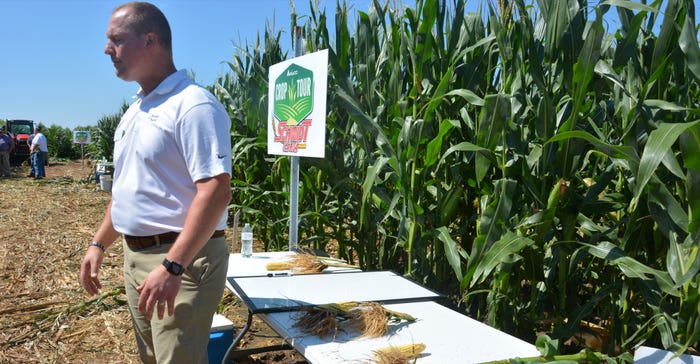
How you plant — population, spacing, depth, down pressure — matters. And when your field undergoes weather challenge after weather challenge, some of those little things count even more. That was the central message from a Kansas Agco Crop Tour near Haven in late July.
The tour showcased the difference it makes to have even placement of one seed at a time with a plot of rows planted with some skips and doubles, compared to another planted with singulation technology. Yield estimates from one plot to another showed a variation of almost 10 bushels to the acre based on ear counts and counts of rows and kernels.
Plots were also planted at depths varying from 1 inch to 3.5 inches deep, with the plots planted at 2.5 inches deep showing the best and most consistent results.
“In most years, you’d be looking to plant deep enough to be in good moisture for germination,” said Ivan Lentsch, Precision Planting technician with Agco. “This year, you could have laid it on top of the ground and been in moisture.”
The Haven area was at 200% of normal rainfall by the field day on July 23.
The challenges to getting the field planted began with last fall’s late, muddy harvest of double-crop soybeans that left the ground rutted and rough with multiple layers of residue. The field was deep-ripped to 16 inches to get the seed bed smoothed out. Prior to planting on April 15, 130 pounds of nitrogen and 40 pounds of potassium were applied. After the field stood in water in May and June flooding, it was sidedressed with nitrogen on June 30.
It was looking pretty good by tour day, with yield predictions for even the least successful planting techniques coming in at well over 150 bushels to the acre.
“And that’s for the stuff that we deliberately made mistakes in planting,” said Mark Brewster, Agco tractor, tillage and seeding specialist. “In the as-planted majority of the field, where we planted with the best technology available, we’re estimating it will make 223 bushels. That’s pretty amazing considering the rough start.”
When, as is often the case in Kansas, the rain stopped and didn’t come again, the field was irrigated. The area received only 1.38 inches of rain for the entire month of July, almost 2 inches below normal. In May, the wettest month in Kansas since record keeping began, the Wichita area got 12.64 inches with another 7 inches falling in June.
Lentsch said that in most years, the most important factor of consistent planting depth is making sure the seeds all stay in the “just right” moisture zone. With this year’s wet planting conditions, the impact of down force on the planter was less apparent because all zones had plenty of moisture.
The Schmidt and Sons Agco dealership in Mount Hope hosted the tour. The Kansas event was one of five around the country, with other tours in Emmetsburg, Iowa; Mosinee, Wisc.; Chillicothe, Ohio; and Calhoun, Ky. The dealership brought the newly introduced Fendt 900 series tractor, a White Precision Planter and several pieces of Precision Planting equipment for farmers to examine during the event.
About the Author(s)
You May Also Like






